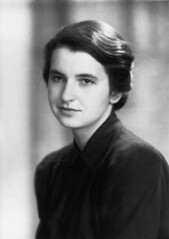Women who paved the way: Rosalind Franklin

Courtesy of Faded Times on Creative Commons
Rosalind Franklin’s discoveries led to advancements in the fields of virology and DNA.
In light of Women’s History Month, The Hawks’ Herald is featuring important women from throughout history. The first week highlights women who have paved the way in science.
Rosalind Franklin was born on July 25, 1920 in London. When she was 18 years old, she began studying physics and chemistry at Newnham Women’s College at Cambridge University. She would go on to work for the British Coal Utilization Research Association during World War II and study the porosity of coal in order to help the war effort — her work then became her Ph.D. thesis.
She received her doctorate degree from Cambridge University in 1945. From 1947 to 1950, Franklin worked at the State Chemical Laboratory in Paris and studied X-ray diffraction technology. She then left Paris and began working as a research fellow at King’s College in the Biophysical Laboratory. She would use her previous research on X-ray diffraction and apply it to the study of DNA, a concept that very little information was known about at the time.
Her research aided in her discovery that DNA is in a helical formation and in finding the density of DNA. Franklin’s discoveries ultimately led to the discovery of DNA existing as a double-helix polymer. Rosalind Franklin went from King’s College to work in the Crystallography Laboratory at Birkbeck College located in London in 1953.
She finished the work she started on coals and DNA. She then began researching the molecular structure of the tobacco mosaic virus. Part of the research she collaborated on displayed that the ribonucleic acid (RNA) in the tobacco mosaic virus was found in the protein and that RNA was a single-stranded helix. Franklin passed away on April 16, 1958 from cancer that most likely stemmed from her work in X-ray crystallography.
The work she completed in her life contributed to the establishment of structural virology as well as the discovery of DNA’s structure. She passed away before the Nobel Prize was awarded for the discovery of DNA. Her work was barely mentioned because of James Watson, Francis Crick and her co-worker Maurice Wilkins. Wilkins had stolen the image that was evidence of the double helix structure without Franklin’s knowledge and showed it to Watson and Crick who went on to say they discovered DNA.
In 1968, Watson published his book titled “The Double Helix” where he described Franklin as a “belligerent, emotional woman unable to interpret her own data.” Rosalind Franklin’s impressive work in the field of physics and chemistry paved the way for future discoveries in DNA and virology but she has only recently received this recognition.
Emily Dvareckas graduated from RWU in 2022 with a degree in forensic science. She spent three years with The Hawks’ Herald as the photo editor...





